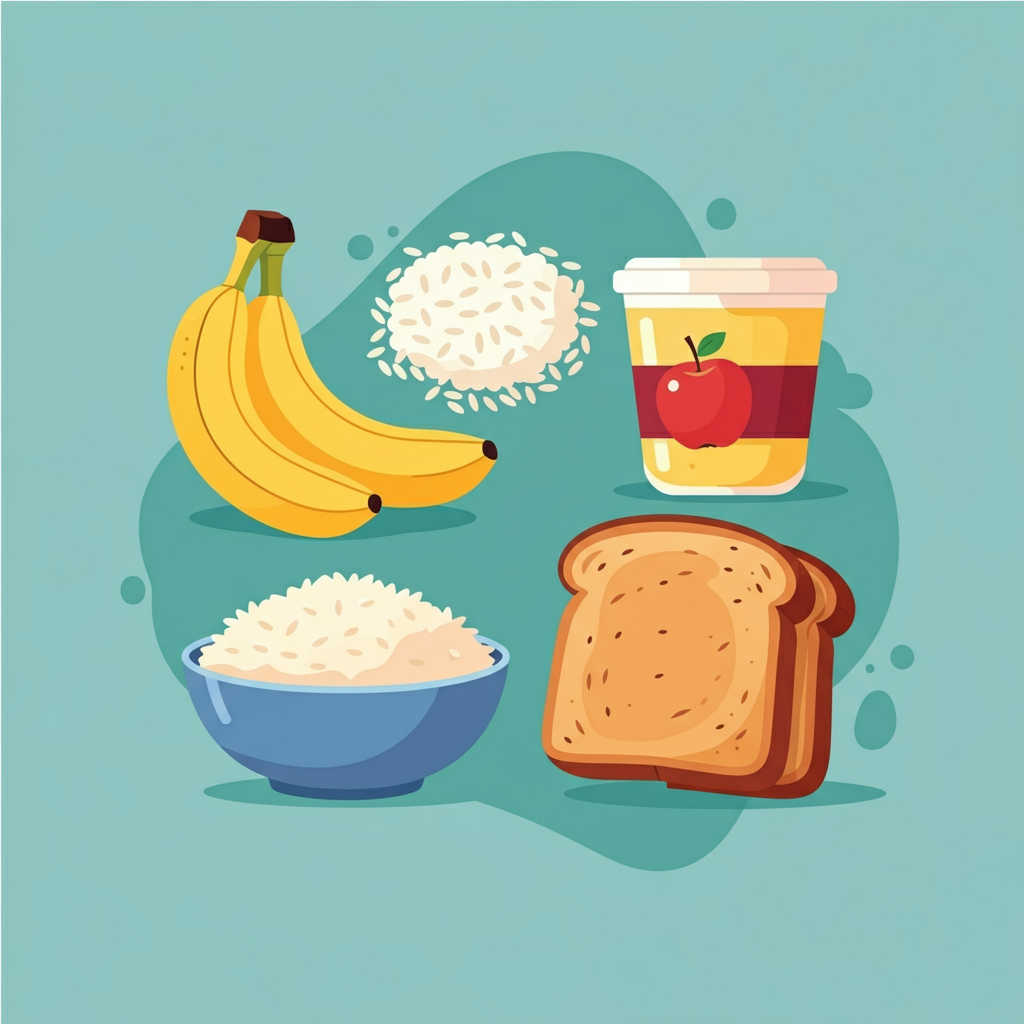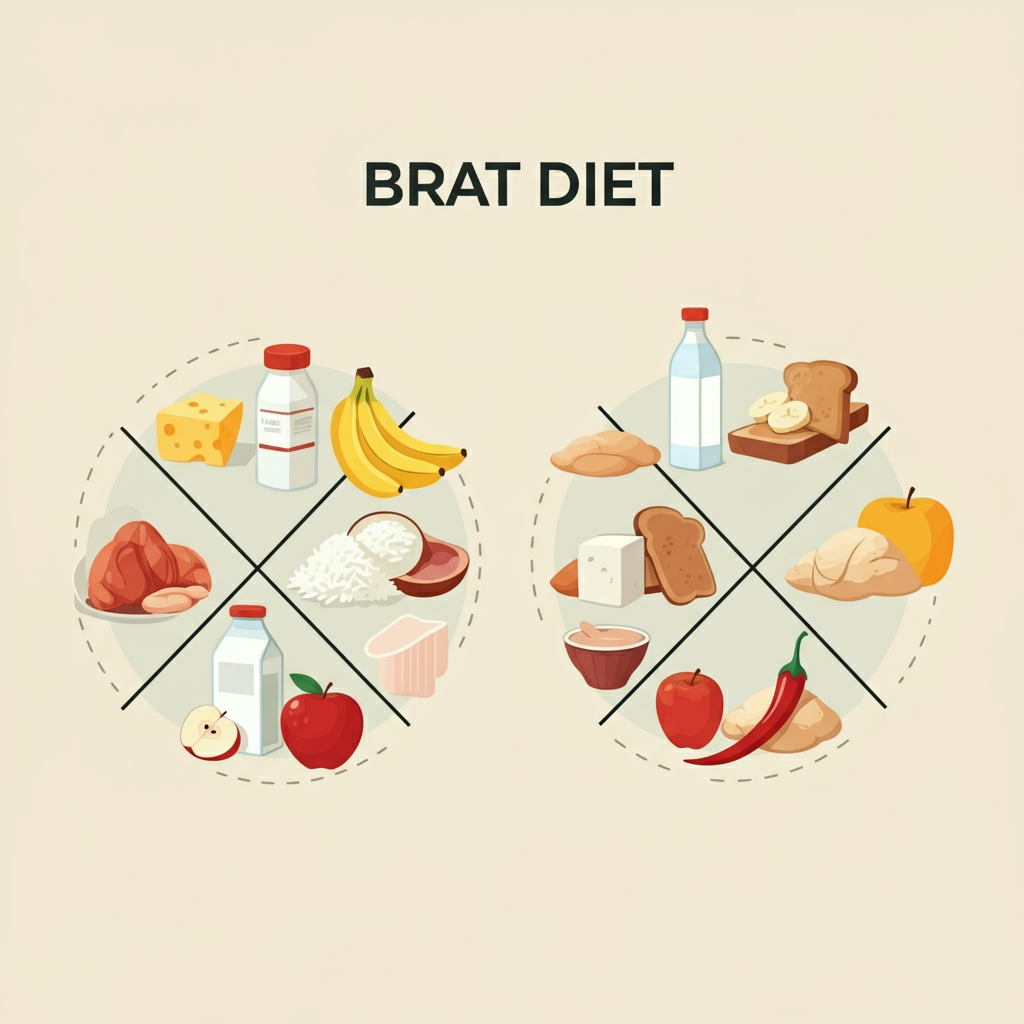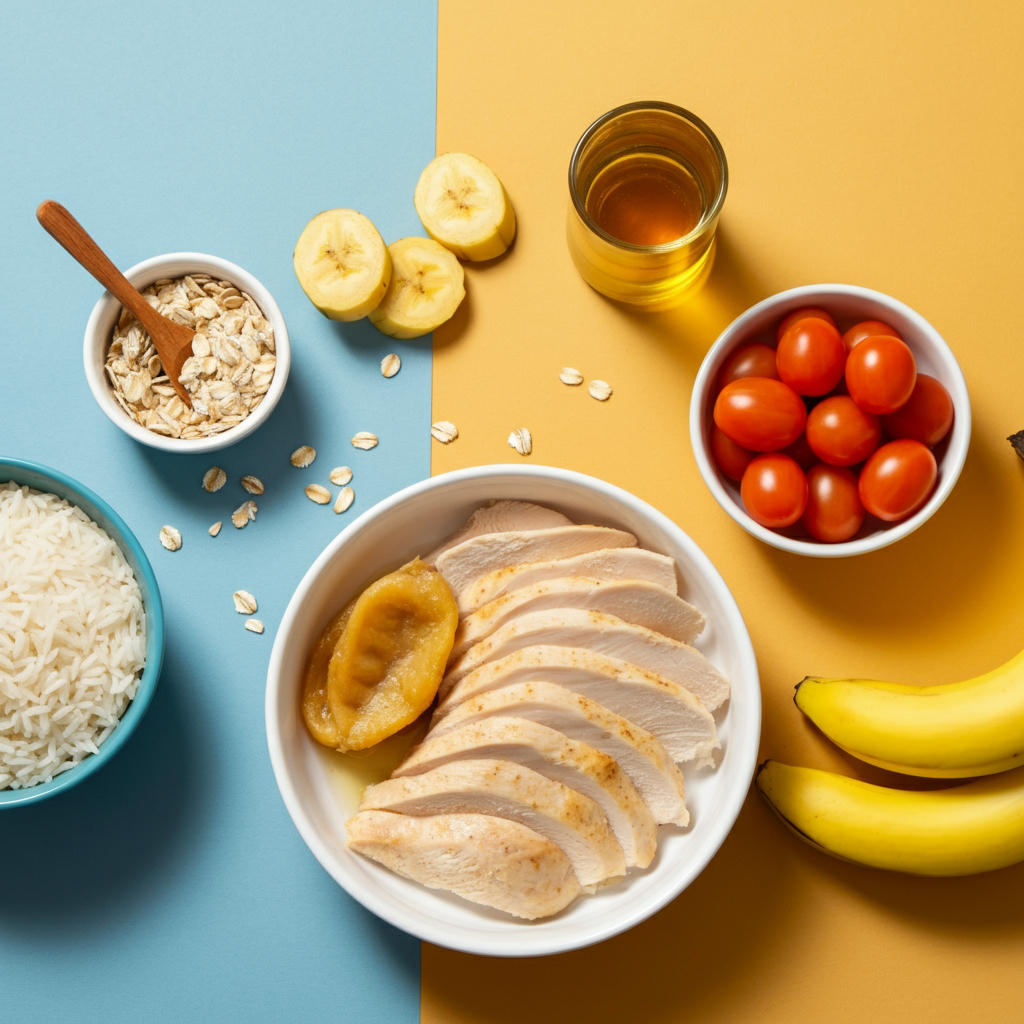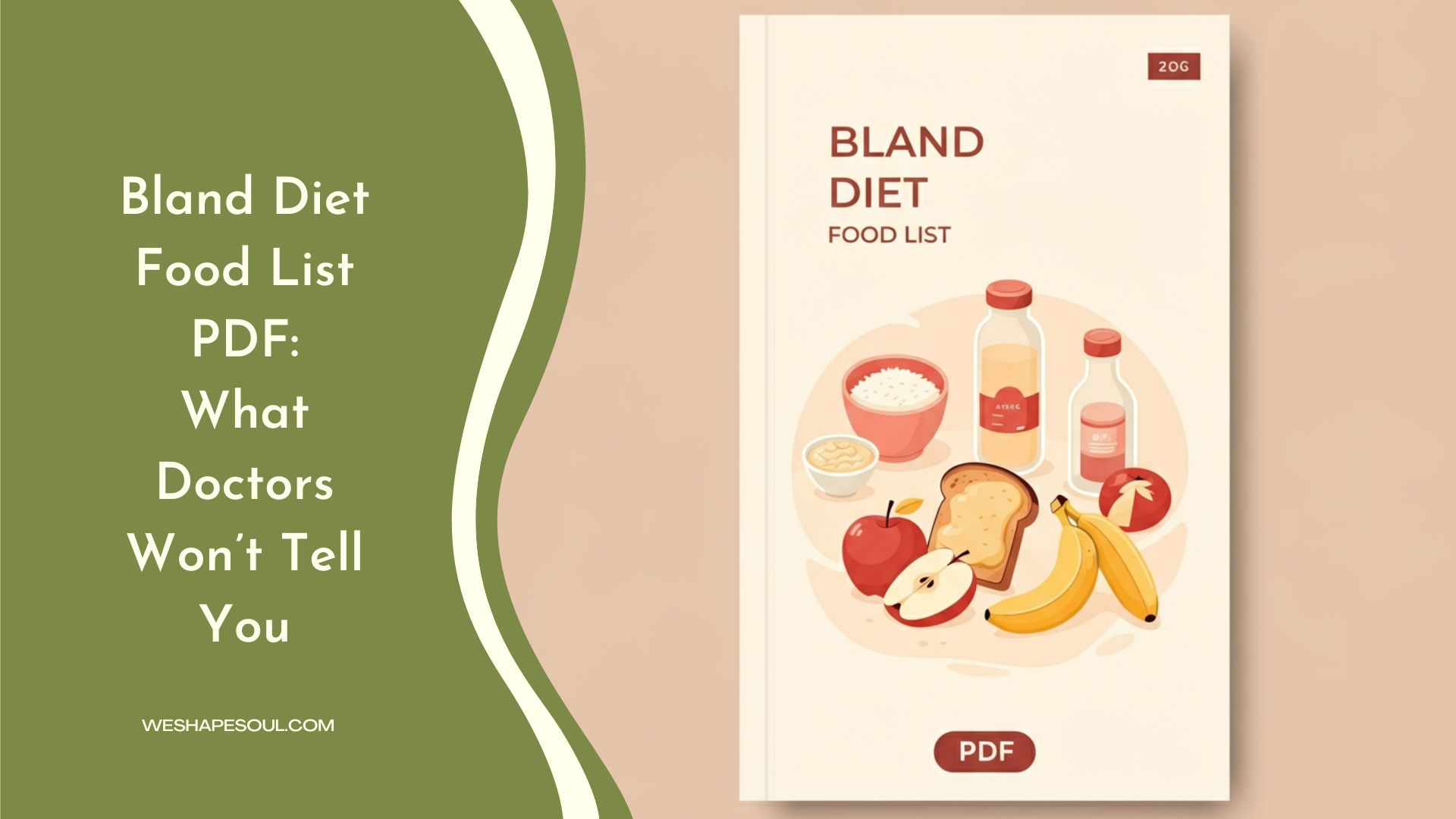Struggling with digestive discomfort or post-surgery recovery?
A bland diet might be the key to easing your symptoms. This blog reveals crucial insights, uncovers what most people miss, and offers an easy-to-download food list PDF.
Start improving your health with practical tips and a clear guide today!
Key Takeaways:
- What is a Bland Diet: A bland diet consists of easily digestible, stomach-friendly foods such as bananas, rice, applesauce, and toast, designed to soothe digestive discomfort, promote healing, and support overall digestive health.
- Benefits of a Bland Diet for Digestive Health: This diet helps manage conditions like gastritis, acid reflux, or stomach ulcers by reducing irritation and inflammation in the digestive system. It emphasizes low-fat, low-spice, and non-acidic food options for improved comfort and recovery.
- Bland Diet Food List & Tips: Stick to foods like crackers, oatmeal, steamed vegetables, lean meats, and non-citrus fruits. Avoid spicy, fried, or acidic items. Opt for smaller, frequent meals to reduce strain on your digestion, and stay hydrated for optimal recovery.
Bland Diet Food List PDF
Allowed Foods
| Category | Examples |
| Dairy | Low-fat milk, Greek yogurt, lactose-free milk, cottage cheese |
| Proteins | Lean meats (chicken, turkey, fish), eggs, tofu |
| Grains | White bread, refined cereals (Rice Krispies, Cream of Wheat), white rice |
| Fruits | Bananas, canned fruits (peaches, pears), applesauce |
| Vegetables | Cooked carrots, green beans, peeled potatoes |
| Snacks | Plain crackers, gelatin, vanilla pudding |
| Beverages | Decaffeinated tea, weak herbal tea, water |
Foods to Avoid
| Category | Examples |
| Dairy | High-fat milk, whipped cream, strong cheeses (blue cheese, Roquefort) |
| Proteins | Fried or smoked meats, processed sausages |
| Grains | Whole-grain bread, bran cereals |
| Fruits | Raw fruits, citrus fruits, berries |
| Vegetables | Raw vegetables, gas-forming veggies (broccoli, cabbage, cauliflower) |
| Snacks | Spicy chips, chocolate-based desserts |
| Beverages | Coffee, alcohol, carbonated drinks |
BRAT Diet Food List PDF
Allowed Foods
| Category | Examples |
| Fruits | Bananas (ripe, not green) |
| Grains | White rice, plain toast, plain crackers |
| Other | Applesauce (unsweetened), plain oatmeal |
| Beverages | Water, weak herbal tea, electrolyte drinks |
Foods to Avoid
| Category | Examples |
| Dairy | Milk, cheese, yogurt |
| Proteins | Fried or fatty meats |
| Fruits | Citrus fruits, berries |
| Vegetables | Raw or gas-forming vegetables (broccoli, onions) |
| Snacks | Sugary snacks, spicy chips |
| Beverages | Coffee, alcohol, sugary sodas |
Additional Tips for Both Diets
- Eat small, frequent meals throughout the day.
- Chew food slowly and thoroughly.
- Avoid eating within 2 hours of bedtime.
- Stay hydrated with water or electrolyte drinks.
- Gradually reintroduce other foods as symptoms improve.
Bland Diet vs BRAT Diet: Key Differences and Uses
| Category | Bland Diet | BRAT Diet |
| Purpose | Designed to alleviate digestive irritation caused by ulcers, heartburn, nausea, vomiting, or post-surgery discomfort. | Specifically intended to manage diarrhea and gastrointestinal distress by firming up stools. |
| Foods to Include | Dairy: Low-fat milk, Greek yogurt, lactose-free options. <br> – Proteins: Lean meat, chicken, fish, eggs, tofu. <br> – Grains: Refined bread, rice, pasta, plain cereals (e.g., Rice Krispies, Cream of Wheat). <br> – Fruits & Vegetables: Cooked vegetables, bananas, canned fruits, applesauce. | Bananas. <br> – Rice (white, plain). <br> – Applesauce (unsweetened). <br> – Plain toast (made from refined bread). |
| Foods to Avoid | Dairy: Whipped cream, strong cheeses. <br> – Spicy or fried foods. <br> – Fibrous or gas-forming vegetables (e.g., broccoli, cabbage). <br> – Whole-grain bread and bran cereals. <br> – Alcohol and caffeine. | Dairy products of any kind. <br> – Fibrous and whole-grain foods. <br> – Spicy and fried foods. <br> – Fruits with seeds or skins. <br> – Caffeinated beverages. |
| Duration | Meant to be followed temporarily (4-6 weeks) or until digestive health improves as recommended by a doctor. | Designed for very short-term use (24-48 hours) to alleviate symptoms during diarrhea episodes. |
| Best For | Individuals recovering from ulcers, acid reflux, or gastrointestinal surgery. <br> – Those needing a gentle diet to minimize digestive strain. | Those experiencing acute diarrhea or gastrointestinal upset. <br> – Situations requiring prompt stool regulation. |
| Key Advantages | Offers a broader range of nutritional options, ensuring a more balanced diet. <br> – Allows for greater variety as symptoms improve. | Simple and highly digestible, ideal for quickly relieving diarrhea. |
Foods to Include in a Bland Diet
If you’re following a bland diet, it’s essential to select foods that’re gentle on your stomach. Below is a simple guide with categorized examples to help you select the best options.
1. Dairy
- Low-fat milk (e.g., skim milk or 1% milk).
- Lactose-free options like almond milk or lactose-free cow’s milk.
- Plain Greek yogurt, which is high in protein and gentle on digestion.
2. Proteins
- Lean meats such as grilled chicken or turkey (avoid seasoning or frying).
- Steamed or baked fish like cod or salmon.
- Eggs (scrambled or boiled for an easier option).
- Soft protein alternatives like tofu.
3. Grains
- Refined cereals like cream of wheat or oatmeal.
- White rice, which is easy to digest and gentle on the stomach.
- White bread or plain crackers, such as saltines.
4. Fruits and Vegetables
- Bananas, which are low in fiber and ideal for sensitive stomachs.
- Canned fruits without added sugar, such as peaches or pears.
- Cooked and peeled vegetables like carrots, zucchini, or green beans.
Actionable Tip
Start with smaller portions of these foods to test your tolerance. Gradually increase the variety and quantity as your symptoms improve. By maintaining a structured and gentle approach, you give your digestive system time to recover effectively.
Foods to Include in the BRAT Diet
Key Foods to Include in the BRAT Diet

The BRAT diet is widely recommended for managing digestive issues. This gentle approach includes bland, low-fiber foods that are easy on the stomach. Here is an overview of essential foods to include:
1. Bananas
- Bananas are rich in potassium, which helps replenish lost electrolytes.
- They are soft, easy to digest, and ideal if you’re feeling nauseous.
2. Rice
White rice, in particular, is a great source of energy and gentle on digestion.
Avoid adding sauces, spices, or oils to keep it plain and stomach-friendly.
3. Applesauce
Applesauce contains pectin, a fiber that can help firm up loose stools.
Choose unsweetened applesauce to avoid adding unnecessary sugar.
4. Toast
- Plain toast provides simple carbohydrates that are easily absorbed.
- Avoid toppings like butter or jam, which may irritate the stomach.
Additional Foods to Consider
If your symptoms improve, you may introduce other gentle foods in moderation:
- Boiled Potatoes: Peel them and eat plain for added carbohydrates.
- Crackers: Unsalted, plain crackers can be a good snack option.
- Clear Broths: Chicken or vegetable broths (without cream) are hydrating and easy to digest.
By sticking to these basic options and avoiding aggressive spices or complex flavors, your digestive system remains calm and on track for recovery.
Actionable Tip
Start with small portions to ensure your stomach tolerates the food. Gradually add variety over time.
Foods to Avoid on a Bland Diet
When following a bland diet, it is essential to avoid foods that irritate the stomach. Some foods are too harsh, greasy, or high in fiber, causing discomfort. Here are specific categories with examples to guide you:

1. Dairy Products
Avoid dairy items that are high in fat or difficult to digest. These can exacerbate symptoms such as bloating or nausea.
Examples to Avoid:
- Whipped cream
- Strong cheeses like blue cheese or cheddar
- Full-fat milk and creams
Instead, opt for lactose-free products or skim milk if tolerated.
2. Proteins
Choose lean, plain proteins and avoid processed or heavily seasoned options.
Examples to Avoid:
- Fried chicken or fish
- Smoked meats like bacon or sausage
- Spicy or marinated meat dishes
Baking or steaming plain proteins, such as chicken breast or tofu, is a safer alternative.
3. Grains
Grains high in fiber or coarse in texture can irritate your system further.
Examples to Avoid:
- Whole-grain or seeded breads
- Brown rice or quinoa
- High-fiber cereals
Opt for plain white rice, refined pasta, or soft sandwich bread.
4. Fruits and Vegetables
Raw, fibrous, or gas-producing options may lead to discomfort or bloating. Choose soft, cooked alternatives instead.
Examples to Avoid:
- Raw broccoli, cauliflower, or cabbage
- Brussels sprouts or onions
- Acidic fruits like oranges, lemons, or grapefruit
Stick to peeled, cooked apples or soft bananas for fruit and steamed carrots or zucchini for vegetables.
5. Fried and Greasy Foods
Greasy or fried foods are heavy on the stomach and can trigger acid reflux or nausea.
Examples to Avoid:
- French fries
- Donuts or fried pastries
- Burgers or fried snacks
Instead, prepare meals with low-fat cooking methods like steaming, boiling, or baking.
Actionable Tip
Keep a food journal to track your symptoms and monitor their relationship to your diet. This helps find patterns and adjust your diet effectively. By removing irritating foods, you create a calm environment for your digestive system.
Foods to Avoid on the BRAT Diet
When following the BRAT diet (Bananas, Rice, Applesauce, and Toast), it’s vital to avoid certain foods that may irritate the digestive system or worsen diarrhea. Below are clear examples and explanations to help guide your choices:

1. Dairy Products
Dairy, like milk, cheese, and butter, can be tough to digest.
Examples:
- Whole milk
- Soft cheeses (e.g., cream cheese or feta)
- Yogurt with added sugars
Dairy products can worsen diarrhea due to lactose. This is especially important if you are lactose intolerant.
2. High-Fiber Foods
Fiber-rich foods like whole grains and raw vegetables may strain the digestive system.
Examples:
- Broccoli or cauliflower
- Bran cereal
- Legumes like beans or lentils
Fiber can be helpful during normal digestion, but it can cause discomfort when your stomach is sensitive.
3. Spicy Foods
Spices can irritate the stomach lining and exacerbate symptoms.
Examples:
- Hot sauce
- Jalapeños
- Heavily spiced curries
Avoiding spicy foods can keep your stomach calm.
4. Fried and Fatty Foods
Greasy or high-fat meals are more difficult to digest, often resulting in stomach discomfort.
Examples:
- Fried chicken
- Potato chips
- Fatty meats like sausage
These foods slow digestion and should be replaced with low-fat options.
5. Caffeine and Alcohol
Both caffeine and alcohol dehydrate the body, which can intensify diarrhea.
Examples:
- Coffee or energy drinks
- Beer or cocktails
Hydration is crucial when following the BRAT diet.
Simple Tips to Remember
- Choose bland, easy-to-digest foods.
- Drink plenty of water or electrolyte solutions.
- Avoid greasy, spicy, or heavily processed meals.
By eliminating these items, you create an optimal environment for recovery while sticking to the BRAT diet.
Sample Bland Diet Menu
Here’s a simple, balanced menu for a day on a bland diet:
Breakfast
- Oatmeal with low-fat milk and a sliced banana.
- A cup of decaffeinated tea for a gentle start to your day.
Lunch
- Grilled chicken breast (skinless) – a light protein source.
- White rice – easy to digest and helps soothe your stomach.
- Steamed carrots – a mild vegetable with essential nutrients.
- For dessert, enjoy unsweetened applesauce.
Dinner
- Baked fish (like cod or sole) – nutritious and low-fat.
- Mashed potatoes (plain, no butter or cream).
- Steamed green beans – another easy-to-digest veggie.
- A small serving of low-fat yogurt to support gut health.
Quick Tips for Following the Bland Diet
- Prepare foods using gentle methods like steaming, boiling, or baking.
- Stick to small portions to avoid overloading your stomach.
- Avoid adding extra spices, heavy seasonings, or fried foods.
Sample BRAT Diet Menu
Sample BRAT Diet Menu
The BRAT diet is designed to be simple, soothing, and easy on your digestive system. Here’s an example menu to guide you through a day:
Breakfast
- A ripe banana (not overripe or underripe).
- A slice of plain white toast (no butter or jam).
Morning Snack
- 1/2 cup of unsweetened applesauce.
Lunch
- 1/2 cup of plain white rice.
- A small serving of steamed, skinless chicken.
Afternoon Snack
- A plain, low-fat rice cracker.
Dinner
- Another slice of plain white toast.
- A small portion of well-cooked, plain oatmeal (without sugar or milk).
Actionable Tips for BRAT Diet Success
- Stay hydrated—sip on clear liquids such as water, broth, or electrolyte drinks.
- Incorporate small, frequent meals throughout the day to avoid stomach overload.
- Gradually reintroduce proteins like boiled chicken or scrambled eggs as you recover.
- Avoid dairy products (except for plain yogurt) if they cause stomach irritation.
Why the BRAT Diet Works
The BRAT diet consists of bland, low-fiber foods that help firm up stool and replenish nutrients while giving your digestive system a break. This diet is particularly beneficial for managing conditions like diarrhea or nausea. Introduce foods slowly to facilitate effective recovery while managing symptoms.
Benefits of Bland and BRAT Diets
Both bland and BRAT diets simplify digestion by providing gentle, easy-to-process meals. They’re ideal for individuals recovering from stomach issues or gastrointestinal discomfort. Here’s why they work effectively and how to implement them at home.

Benefits of Bland Diet
The bland diet includes non-irritating, mild foods that soothe the digestive system. It’s particularly helpful for conditions such as ulcers, GERD, or after gastrointestinal surgery. Here are its key benefits:
- Reduces stomach irritation: Foods like plain rice, boiled chicken, or oatmeal are gentle on the stomach.
- Eases symptoms of heartburn (source): Adjusting your diet can alleviate acid reflux.
- Supports recovery after surgery (source): Soft foods ensure your digestive system heals without added strain.
How to Follow a Bland Diet
- Stick to foods like boiled potatoes, applesauce, and skinless poultry.
- Avoid spicy, fried, or acidic items to prevent further irritation.
- Include herbal teas like chamomile for additional soothing benefits.
Benefits of the BRAT Diet
The BRAT diet—bananas, rice, applesauce, and toast—is a go-to for managing diarrhea. These foods replenish lost nutrients while firming up stool.
- Replenishes potassium: Bananas help restore vital electrolytes lost during diarrhea.
- Improves stool consistency: Low-fiber options like white rice aid in recovery.
- Reduces nausea and vomiting by providing bland, easily digestible calories.
Healing Your Gut with the BRAT Diet
- Start with small amounts of rice and toast to analyze tolerance.
- Gradually add bananas or applesauce for energy and nutrients.
- Pair the BRAT diet with hydration, drinking water or electrolyte solutions.
Actionable Tips for Both Diets
- Avoid salty or processed snacks that can worsen dehydration.
- Maintain hydration by drinking plenty of water or clear broths.
- Reintroduce other foods slowly, based on how your body reacts.
These diets are more than just guidelines—they’re proven tools for restoring digestive health.
Challenges and How to Overcome Them
1. Limited Food Variety
Sticking to these diets often presents the challenge of reduced food options.
Why it’s a problem: Repetitive meals may lead to loss of appetite or boredom with eating.
Solution:
- Rotate ingredients weekly to create diverse meals.
- Experiment with safe spices or mild herbs to add flavor (e.g., cinnamon or ginger).
- Introduce new fruits like pears instead of bananas, ensuring they align with the diet’s rules.
2. Difficulty Meeting Nutritional Needs
Restrictive diets sometimes fall short of providing essential vitamins and minerals.
Why it’s a problem: Prolonged nutritional gaps may weaken the immune system or cause fatigue.
Solution:
- Work with a registered dietitian to ensure an optimal nutrient balance (find one here).
- Supplement with multivitamins or minerals if approved by your healthcare provider.
Include natural sources like boiled spinach or soft-cooked carrots for iron and fiber.
3. Maintaining Hydration
People often forget a crucial part of recovery—staying hydrated alongside the diet.
Why it’s a problem: Dehydration can worsen symptoms or even delay the healing process.
Solution:
- Drink electrolyte drinks like coconut water for natural rehydration (source).
- Keep a bottle of water nearby as a reminder throughout the day.
Include broth-based soups to hydrate and soothe digestion.
4. Meal Planning Consistency
Failing to plan meals can cause stress or reliance on unsuitable quick options.
Why it’s a problem: Unplanned choices tempt people to eat processed or unhealthy food.
Solution:
- Use printable meal planners or apps to organize weekly meals.
- Prep ingredients in advance, like pre-cooking rice or cutting fruits.
Incorporate “safe snacks” such as rice cakes or apples as backups.
Practical Reminder for Success
- Listen to your body and adjust portions based on how it feels.
- Avoid overly processed condiments or pre-packaged meals that might disrupt recovery.
- Begin slowly transitioning back to a normal diet only after symptoms fully disappear.
These actionable steps aim to simplify challenges so your healing process stays on track.
FAQs
What is a bland diet and who should follow it?
A bland diet consists of foods that are soft, low in fiber, and not heavily seasoned or spicy. It is often recommended for individuals recovering from gastrointestinal issues, surgery, or certain illnesses to reduce irritation and promote healing.
Can I find a comprehensive bland diet food list as a PDF?
Yes, there are many resources online where you can download PDF guides for bland diet food lists. These often include categorized food options, meal planning tips, and portion recommendations for optimal recovery.
Are there any high-protein options on a bland diet?
Absolutely! Foods like plain boiled chicken, turkey, eggs, tofu, and certain types of fish like cod or tilapia are bland yet high in protein, making them suitable for maintaining muscle and energy levels.
What foods should be strictly avoided on a bland diet?
Common foods to avoid include spicy dishes, fried foods, caffeinated beverages, alcohol, and high-fiber items like raw vegetables, whole grains, and legumes, as these can irritate the stomach or intestines.
How long should I stick to a bland diet before transitioning back to normal eating?
The duration of a bland diet depends on the condition being treated. Most individuals follow it for a few days to a couple of weeks, but you should consult a healthcare provider to determine the ideal timeline for your situation.


Leave a Comment